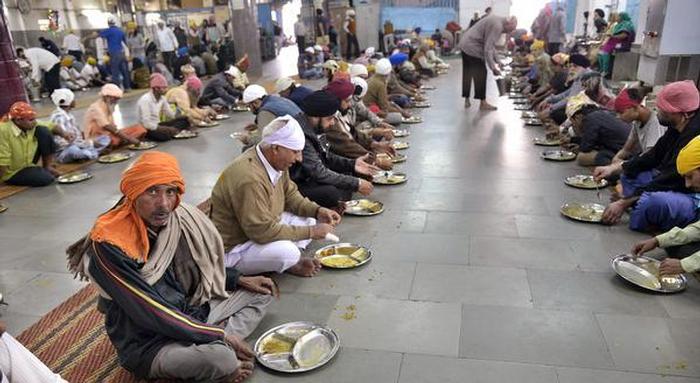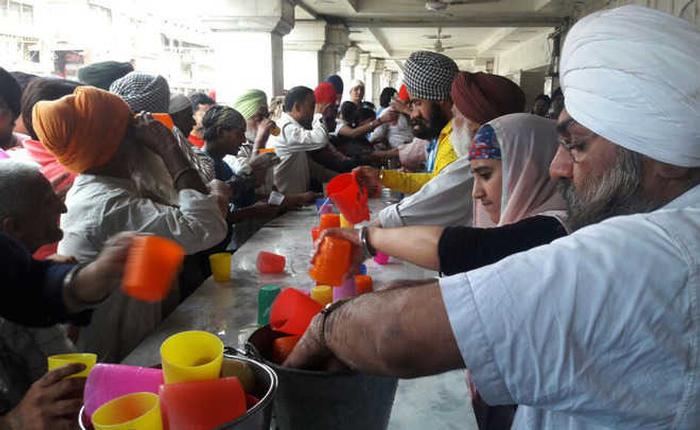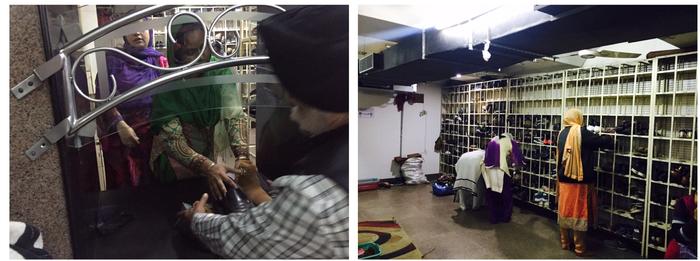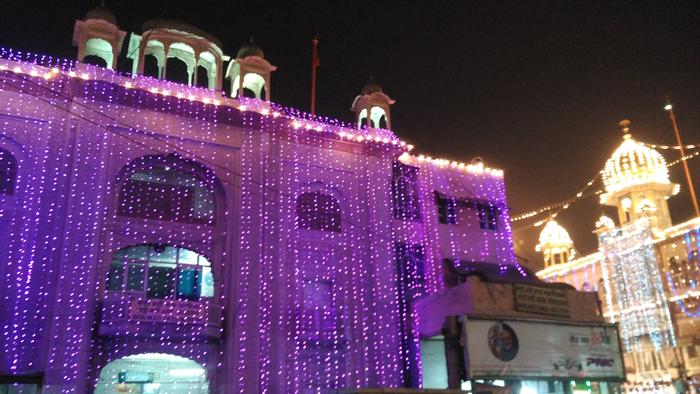[ID:2391] Religious Built Environment as a Collective MemoryIndia In my childhood, every night before going to sleep, I used to cuddle with my grandfather and wait for him to tell me a story. He told me hundreds. Before starting to read and research for this final essay, I was reminded of one which has stuck with me through all these years.
“Do you know about the history of Gurudwara Sis Ganj Sahib, Avi? The one where we go to every Sunday”, he asked me. Before every story, I used to ask him to not ask me rhetorical questions, because I never knew answers to any.
So he started. “You know the Gurudwara is known as Sis Ganj because the ninth Sikh Guru- Guru Tegh Bahadur was beheaded by the then Mughal leader Aurangzeb under the same tree trunk that we see in the Gurudwara. Sis means head, and the shrine was built a century later by one of his disciples- Baghel Singh as an agreement between him and Mughal Emperor - Shah Alam II, after Baghel Singh occupied the Hall of Audience of Red Fort, in the memory of the guru on this historical site.” I interrupted him, “Why was Guru Tegh Bahadur beheaded, though?” He had already anticipated the question and was ready with the response, “Due to the dominance of the Mughal Empire in Delhi, people were being forced to convert to Islam. Guru Tegh Bahadur, after a lot of pleas from Kashmiri pandits took charge of the situation and fought for people’s right to choose the religious paths that they wanted to follow. Following his actions, the guru was beheaded in front of hundreds of people.” I gasped at the visuals the story made in my mind. “This is not to tell you about his assassination, son. Remember how I have always told you that Sikhism preaches ‘service for humanity’, this story is an example of the same. Guru Tegh Bahadur stood firm for the rights of people. He followed the right path and made sure that people could practice the religion they wanted. He fought for the people irrespective of them being Sikhs or not. This is what I want you to learn from him - stand for humanity.” One lesson learnt well. I slept.
The Sis Ganj Gurudwara is one of the nine historical Sikh shrines in Delhi. It is located in Chandni Chowk in the old city of Delhi - Shahjahanabad. Apart from the Gurudwara (Sikh community), Chandni Chowk also houses the religious centres of the three most identifiable communities that live here- Lal Mandir (Jains), Jama Masjid (Muslims), and Central Baptist Church (Christians) Interestingly, these religious centres are situated 500 meters from each other on the Chandni Chowk Road besides Jama Masjid, which abuts the Esplanade Road, 200 meters right of Chandni Chowk Road.
Over the past two centuries, the Gurudwara has seen a variety of additions and changes done to it, both architecturally and spatially. It is of utmost importance to understand that Gurudwaras do not conform to any strict architectural design or order. To propagate the idea of Gurudwaras as Sikh religious centres and community spaces, and to disseminate the social and cultural beliefs that Sikhism preaches, every Gurudwara is seen to have a few specific essential spaces and an overall facade outlook.
The Sis Ganj Gurudwara (like any other Gurudwara) has a tall Sikh pennant flag atop a pole (known as the Nishan Sahib) which identifies the presence of the Gurudwara from a distance. It has five gold guild domes which take their shape from a ribbed lotus, and are topped by ornamental pinnacles. It has a main assembly hall with the sanctum at one corner- a raised platform (like a lectern) that holds the holy book with scriptures and hymns - ‘Guru Granth Sahib’ which is covered with a royal canopy, with ample space for circumambulation. The Guru Granth Sahib is considered as the living Sikh Guru as it was named as his successor by the tenth guru - Guru Gobind Singh. The granth (book) has a pivotal role in the Sikh congregation. A verandah skirts the hall for proper augmentation of space, and gives access to the hall from all the four sides. It is observed that men and women sit on either sides of the sanctum respectively to maintain equality between the two. There is an upper floor to the main assembly hall which is used to accommodate people during peak inflow hours. There is a direct view of the sanctum from the upper floor which is achieved with the help of courtyard like planning. Small rooms which hold a copy of the Guru Granth Sahib run along the entire periphery of the upper floor. These rooms are occupied by paathis (guru’s disciples) who read the holy scripture in pure silence (akhand paath) for the people.
The Sikh Community is based on the idea of ‘Pluralism’ wherein the Sikh Gurus have propagated the message of "many paths" leading to the one God and ultimate salvation for all souls who tread on the path of righteousness. Guru Granth Sahib transcends creed and caste, race and convention. It does not belong to the Sikhs alone. The Guru Granth Sahib provides unique guidance and advice to the whole of the human race. As a community, Sikhs are told to accept all leading faiths as possible vehicles for attaining spiritual enlightenment, provided the devotees show reverence to the teachings of their respective religions.
Being born and brought up in a Sikh family myself, the practices of the Sikh community have always fascinated me. Therefore, I am going to look at the community’s beliefs, its practices and the use of the religious built environment of the Gurudwara from a pragmatic standpoint. It is important to delve deeper into the social endeavours of the Sikh community which focuses on communal service. I’ll do the same by citing a one-day event which brought the entire Sikh community and thousands of people of Delhi together under the roof of Gurudwara Sis Ganj Sahib.
5 January 2017 marked the 350th birth anniversary of the son of Guru Tegh Bahadur - Guru Gobind Singh. It was a grand occasion for the Sikh community, and my family isn’t one to be left out. All of us wore our traditional dresses and reached Gurudwara Sis Ganj Sahib at 11am in the morning. Not much to our surprise, the entire road stretch from the Metro Rail station to the entrance of the Gurudwara was jam packed. It took us about 20 minutes to reach the entrance of the Gurudwara complex.
My mother religiously follows Sikhism, and she has always told me how ‘selfless service without desire for reward’ forms the premise of the institution of Sikh thought; this thought takes shape in the form of Seva, that is service rendered to humanity. In traditional Indian society work involving physical labour was considered lowly and was relegated to lower castes. The Sikh Gurus sanctified manual labour as honourable religious practice and established the concept of ‘dignity of labour’. It all made sense to me now.
Before entering into the main assembly hall with the sanctum, we had to take off our footwear and keep them in the ‘joda ghar’ (rooms which safely store footwear in return of a token number). In every joda ghar, there are men and women alike who do Seva, and manage the entire process of taking shoes from the common man and returning it to them later. It is a very organized activity wherein no footwear is lost. It is important here to note that no specific person is assigned the job, and any common person - you and me alike can take up the service. The people who do Seva also indulge in cleaning and polishing the footwear of people as a part of selfless service for humanity. To the right of the joda ghar, there is a small room where mops, buckets, and brooms are stored. Like service in the joda ghar, I saw people voluntarily cleaning the entire premises of the Gurudwara. The cleaning was done in turns at various places in the complex. I have witnessed my mother and sister washing and cleaning the main assembly hall on various occasions during the night time after the Guru Granth Sahib is taken in the sacred room.
After removing our shoes, we proceeded to wash our hands. There are basins lined just before the flight of steps leading to the sanctum hall. Here, before the first step, lies a small pool of water which serves the purpose of washing/ cleaning of feet before entering into the hall. As my mother and father proceeded inside the main hall, my sister and I stood in a queue to buy Karha Prasad (it is a sweet of religious offering which is distributed amongst all people in the Gurudwara). It is not mandatory to buy karha prasad, but people do it as Seva through material resources for the greater good of humankind and to seek blessings from God. Funnily though, I remember how as a kid I used to get excited to go to Gurudwaras only because we used to get Karha prasad. It has still not changed. The kid in me still goes to Gurudwara for the same.
In Sis Ganj Gurudwara complex, a big hall is used as a Langar Hall. A langar hall is a space in a Gurudwara where all people irrespective of their caste, creed, sex, color, religion, economic status are provided free vegetarian meals everyday. Everyone sits on the lines of carpets on the floor to eat langar. As a family, we have been practicing Seva in the langar hall for many years now, and today was nothing different. My mother helped in cooking food, which included grinding corn, preparing curries and rice, and cutting vegetable. I have always loved distributing dishes (plates, bowls, spoons and glasses) to people, while my father helped in serving food. As practice, everyone who eats langar washes their own utensils, but there are people who willingly wash the soiled utensils. My sister took up the Seva of washing utensils. During the entire course of the day, about 15,000 people were fed langar in the Sis Ganj Gurudwara. Seva is also rendered through one’s material resources wherein people donate grains and pulses for the preparation of langar. My grandfather used to run a daily-needs based grocery store in the local market and he used to donate kilograms of pulses in Gurudwaras. Recently, after my grandfather and grandmother passed away, my entire family has made it a point to donate the same in my grandparents’ names.
‘Ek pyaase ko paani pilaane se zyada punya ka kaam koi nahi hota hai’ ‘There is no service bigger than serving free water to people’ In India, everyone is taught to follow the aforementioned. No one denies water to any person in need or otherwise. Sikhism preaches and practices this with great willingness.
Post the routine seva, worshipping the god, and eating a fistful of karha prasad, we proceeded out of the Gurudwara under a colonnaded shaded pathway which houses the ‘Piao/ Chhabeel’ leading to the joda ghar. The Piao or Chhabeel is a platform space in every Gurudwara where Seva of free water is practiced. Water is served to all people irrespective of them being devotees or not. As a matter of fact, the piao serves water to thousands of passerby's on a daily basis.
It was after almost a year that I was visiting Gurudwara Sis Ganj, and I was shocked to see that the Piao was missing. Instead, three make-shift plastic tables were put in the space to serve water. One of the people serving there filled me in on the happenings which lead to the destruction of the Piao. He said and I quote, “At 6:00 in the morning of 6 April 2016, the Gurudwara’s Piao was openly attacked by the Municipal Corporation of Delhi accompanied by the Delhi police. The alleged attack was carried out on orders of the High Court, but the same was rubbished as the Gurudwara is a heritage building which cannot be destroyed. After protests from the Sikh community, the reconstruction of the Piao was carried out by Sangat (devotees). As you can see, the Piao is almost back in its original form. We hope that it gets constructed quickly because the service has been gravely affected.” I was shocked and enraged myself after acquiring knowledge about this incident.
It was already dark. The Gurudwara - studded with strings of lights was glowing brightly exuding hope and prosperity for humankind. I could see a thousand selfless eyes gleaming with fulfilment and gratification. On the other side, I saw a hundred gleaming eyes ready to take shelter under the shaded verandah that skirts the main assembly hall. The Gurudwara premises are open 24x7, and have served as shelter for homeless people of Chandni Chowk for decades. With abundance of positivity in our hearts, minds and bodies, we took the next train home.
POST SCRIPT
I do not hold faith in any religion, and consider myself an agnostic. Often, I find myself sitting on the white-marbled steps of the Gurudwara. The atmosphere is very serene and tranquil. It imbibes a positive energy in me. More than that, I think I keep on coming back to the Gurudwara to restore my faith in humanity. I wholeheartedly believe in the institution of selfless service, and according to me, there is no better place to practice the same other than a Gurudwara. The Gurudwara is one place which erases the very thick lines which exist between the rich and the poor; man and woman; brown and white; hindu, muslim, sikh, and christians in India. It brings all of human race under one canopy of equality and goodness. On a very personal level, the journey of writing this essay was a revelation for me. It was insightful to gain knowledge about the social art of architecture, through its confrontation with the Sikh community. I learnt a lot, and sincerely hope that it brings about a positive change in at least one person who reads it.
If you would like to contact this author, please send a request to info@berkeleyprize.org. |




